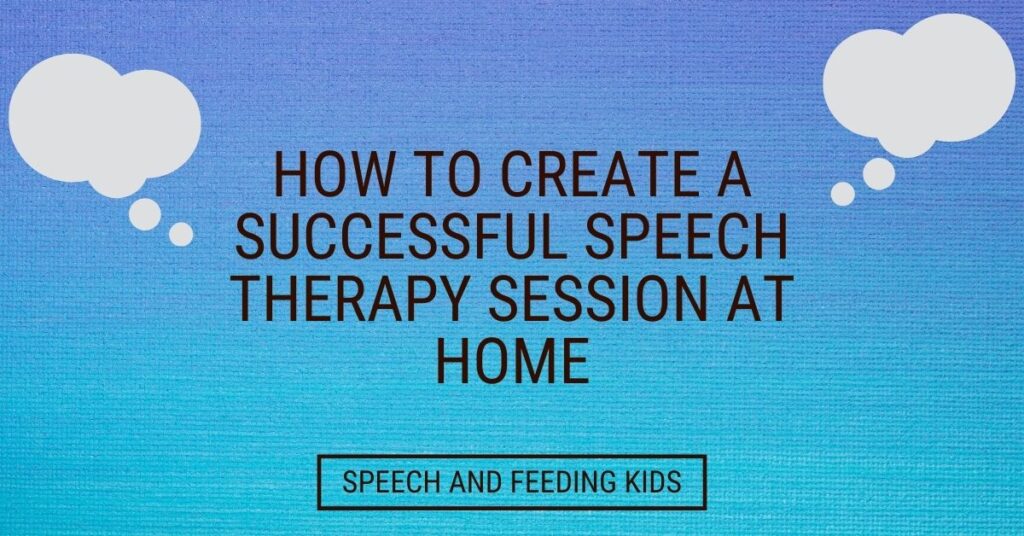Many of you are being asked to carry out the role of your child’s speech therapist during this time of distance learning. It’s one more hat you’re being asked to wear since the schools have gone remote.
As a parent and a speech-language pathologist, I have some tips and strategies to share with you on how to help create a less stressful, and more successful at home speech therapy session for your child.
This post may include affiliate links. As an Amazon Associate I earn from qualifying purchases. Read the full disclosure here.
5 Areas to Focus on a Successful Home Speech Therapy Session
Environment
Inside
Find a quiet, de-cluttered space that becomes your consistent area to sit and do your speech work. This could be a table in your playroom, your kitchen table, or a plastic table setup in your garage. The key here is to create a space that is comfortable and not distracting.
Outside
If minimal materials are needed, or you just need your iPad, consider doing speech on your swing set, a shady spot under a tree, or a blanket on your front yard.
Experiment with any one of these and see how your child responds. You can also ask your child and see if they will show you if a certain location would excite them.
If the child is able to concentrate and they are motivated by movement, try the swing set. If more structure and stillness is needed, stick with sitting at a work space. Consistency is key once you’ve found the place that works best. The act of walking towards and sitting down at the consistent area will be a cue in itself that it’s time to practice speech. Working in a familiar consistent area also helps with recall and memory*
Have a clear understanding of what you’re asking your child to do
For the adult
Have a clear understanding of what you are trying to accomplish, and what you will accept as the minimal amount of work. For example if you have two different sounds you want to work on you can go into the session thinking, “We are going to work on /s/ and /l/, for 20 repetitions each”, or “We are going to work on /p/ and /b/ for 5 minutes”.
Quantify the amount of work based on your tolerance, and the child’s the ability to attend and tolerate the demands being placed.
For the child
Make it abundantly clear what it is that you’re both about to do. Depending on their age you can use visuals for younger children (e.g. check marks, stickers), or for older children explain in depth what you want to do. “We’re going to work on /p/ and /b/, let’s see if you can do 20 words each”.
Make it clear what the reward/break system is that they will earn
Understanding what the motivation is, and when it will be offered is the key to getting children to work with you.
As an adult, imagine working a job, and not knowing when you were going to get paid for your work. Talk to your child before, during and after to make it clear that when they do the work, the get the reward.
I have a “magic box” that kids at my office get to earn a trip to for doing good work. It’s a Tupperware container filled with stickers and small party favor toys. As soon as we sit down I start to get the child excited about what they can earn if they listen well and do good work.
At home I have my own kids work a very brief game on the iPad (1-2 minutes at a time), once they complete a segment of our session.
If extra motivation is needed to start/complete our sessions, I will tack on a small sweet treat at the end of the session. This could be a couple of M&M’s or a Twizzlers. I don’t offer this reinforcement to every session. If the child is having a hard day, or if they won’t come to the table at all, I will add an extra level of reward.
Keep the sweet treat reinforcements small. Once you open Pandora’s box to giant treats, they aren’t going to go back to being motivated by 2-3 Skittles.
Make it as fun as possible
Pair speech therapy with a preferred healthy snack and find the activities (coloring, cutting, movement) they love to play during the sessions. If you start to see them really struggling, or notice yourself becoming upset, take a break or just stop for the day.
Note how many attempts they completed and try to do a little more the next time you sit down.
You have to end on a positive note. If the last thing they remember about their session is you getting upset, or that they got in trouble, it’s going to be that much harder next time to get them to sit with you. They are going to associate speech with frustration and mom/dad getting upset.
Start small
If your child completes five repetitions and starts to lose it, see if they can do seven the next time. If they sit with you for three minutes the first session, see if you can get them there for four minutes the next session.
Take any attempt and any compliance as a win.
As a speech-language pathologist with 10 years of experience I struggle with compliance during speech at my office, and even at my home with my own children. Give yourself a pat on the back for even trying to take on the role of your child’s therapist and know that it’s not easy. When things get tough, tell yourself, ‘we will try to get a little further next session”.
Good luck and have fun!
For more speech and language tips, follow Speech and Feeding Kids on YouTube.
About the Author
DRAKE HASTINGS M.S., CCC-SLP
Drake Hastings is a speech-language pathologist who specializes in speech, oral motor, and feeding therapy for kids. Drake has a passion for working with children and families while helping children achieve goals using a fun and motivating approach to learning.
Drake’s main areas of focus within the practice are feeding therapy, and speech (sound production) therapy. Drake has experience working with children who are diagnosed with Autism Spectrum Disorder, Apraxia of Speech, Dysarthria, Down Syndrome, and rare genetic disorders. Drake has experience working and collaborating with a wide variety of families and therapeutic team members while treating children of all ages.


